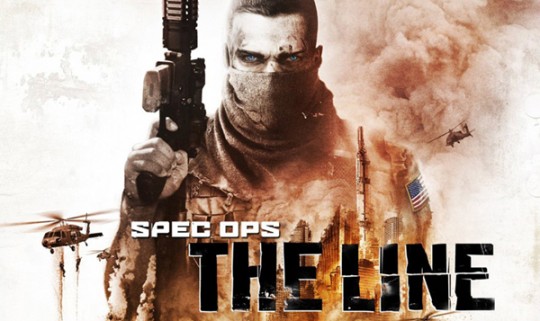Brendan Jacques
Connector Staff
The vast majority of modern video games are built around murder. From the gritty post-apocalypse of “Gears of War” to the bright, grassy plains of ‘Super Mario Bros,” there’s always some enemy standing in the way of the player’s goal, and more often than not, that enemy isn’t going to last very long. Why would it? The hero has to save the world, and the player needs to guide them there; there is no time to question the morality of killing a program made up of ones and zeroes. That’s how video games work, have always worked and always will work.
With this in mind, the existence of a game like “Spec Ops: The Line” seems like a contradiction. It’s a game that builds itself around having the player kill hundreds of enemies while condemning everything it has the player do. It’s a game that despises the likes of “Call of Duty” and “Gears of War” with a burning passion while marketing and designing itself as a rip-off of both of the above. By all accounts, it’s a game that most would expect to be a terrible anti-war propaganda game.
Which is why it still blows my mind that it is not only a fantastic game in its own right, but also succeeds in absolutely everything it tries to do. Atmospheric, dark and beautiful in all the wrong ways, “Spec Ops: The Line” is an underappreciated classic that deserved more attention and praise than it ever got.
The story centers on Sergeant Walker, a U.S. soldier whose squad is sent on a reconnaissance mission into the city of Dubai, which, prior to the beginning of the game, was hit by a sandstorm the likes of which humankind has never seen before. The city is now almost completely buried, with all civilians and soldiers within the city presumably dead. Recently, however, an American military transmission was discovered broadcasting from the city presumably sent by the 33rd Battalion, a group of U.S. soldiers who deserted in order to save as many civilians as possible. Now, several months later, Walker and his squad have been sent in to rendezvous with the 33rd’s leader, General Konrad, assess the situation within the city and assist in rescuing as many survivors as possible. Naturally, as this is a video game, things really don’t go as planned.
Without question, the story of “Spec Ops” stands as its absolute greatest achievement. On the surface, the game seems to be fairly predictable, with the usual breed of over-the-top military machismo, speeches about “fighting for what’s right” and generically evil enemies to fight. In fact, the first few hours of the game could honestly have been ripped straight from the average “Call of Duty” knockoff. The genius of the story, however, is that it’s completely aware of its audiences’ expectations, uses its opening to subtly reinforce those expectations then spends the rest of its runtime tearing them to the ground.
While at first all the main characters seem to fall under the usual military character stereotypes, – the valiant leader, the snarky sniper and the black explosives specialist – as the game progresses those pre-defined characteristics slowly fade away. As they make their way further and further down into the ruins of the city and witnessing the atrocities that occurred in its final days, they all start breaking down under the weight of it all. What only pushes them even further to the edge of sanity is the atrocities they themselves are forced to commit in the name of the mission and their own survival. It’s incredibly thought-provoking stuff, bringing to the forefront commentary on American interventionism, what humans are capable of doing when given no other options and the lengths men will foolishly go to do what they think is right.
I know that I’m being incredibly vague as to what exactly happens in the game, but trust me when I say that you don’t want it to be spoiled for you. It’s one of the best stories ever told in gaming, in my opinion, and is worth the price of admission alone.
Compared to the plot of the story, the gameplay itself is pretty standard fare. The game is a third-person shooter with a heavy emphasis on squad tactics and cover, making it play very similarly to “Gears of War.” Where it distinguishes itself slightly is with the ability to mark targets for your squad-mates, allowing them to assist you with covering fire or sniper support, making your teammates far more useful that AI teammates usually are in these types of games. Outside of that, the only other notable feature of the combat is its use of sand, from the consistently blinding sandstorms to the ability to shoot out windows to pour sand onto your enemies, though admittedly this feature is mostly contextual and not hugely interesting outside of a few scenes.
Regardless of its lack of originality, the gunplay is consistently solid and never really gets boring, with plenty of well-designed set piece moments sprinkled throughout in order to keep things fresh. Also it could be argued that the gameplay is intentionally uninspired to fit more closely with the game’s narrative, though that’s a theory for another day.
“Spec Ops: The Line” is a game that no one saw when it came out and barely has a copy sold to its name, which I see as a travesty. While it’s admittedly fairly short, (clocking in at 7 hours) and isn’t the most tightly balanced game, it has easily the best story I have ever seen in a video game, sticking with me months after I had first finished it. If at least one more person buys this game based on this review, then I’ll be satisfied. There is no excuse this time; if you want to see a real gaming masterpiece, you owe it to yourself to buy this game. “Spec Ops: The Line” is available for Xbox 360 and PS3 for $20 and on PC for $30.
Final Grade: A




